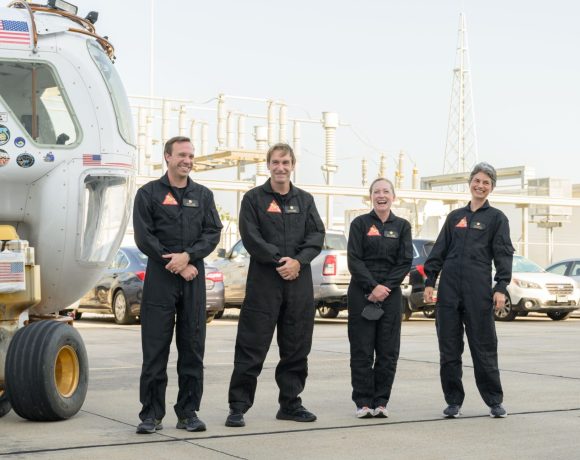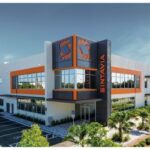LEAP 71 sets new record with AI-designed 3D-printed rocket engine

Thruster successfully passes hot-fire test
LEAP 71, an AI engineering startup based in Dubai, United Arab Emirates (UAE), has achieved an unprecedented record in aerospace technology with the successful hot-fire test of its advanced 3D-printed liquid-fuel rocket engine entirely designed by AI and developed in the UAE.
The company’s proprietary Noyron computational model autonomously designed the rocket thruster without human intervention, making it the first liquid-fuelled rocket engine to be developed in the UAE.
The copper-fabricated Noyron TKL-5 compact engine is suitable for the final kick stage of an orbital rocket and achieved a thrust of 5 kN (equivalent to approximately 500 kg/1124 lbf), generating the expected 20,000 horsepower during the test conducted on June 14, 2024, at a rocket test stand in Wescott, UK.

The engine underwent an initial 3.5-second hot firing using an oxidizer-to-fuel ratio of 1.8, which is lower than the standard 2.3 ratio. This adjustment resulted in a slightly lower combustion temperature.
Following successful performance checks and ensuring all temperatures were within expected parameters, the engine underwent a full 12-second burn test at the standard oxidizer-to-fuel ratio 2.3.
The engine operated according to expectations, achieving a steady-state condition suitable for prolonged operation as needed. The duration of the burn was limited only by the available fuel supply at the test site.
The successful hot-fire test breakthrough marks a paradigm shift in AI-empowered engineering. It paves the way for a future where complex physical objects, such as our rocket engine, can be autonomously conceived and manufactured with unprecedented speed and efficiency, ushering in a new era of aerospace technology.
Aerospace community boost
LEAP 71’s achievement is a testament to the power of collaboration. The thruster was produced in a joint effort with AMCM, a reputed German metal 3D printing firm, and the University of Sheffield, UK, ensuring the highest production and testing standards. This shared success is a milestone for the entire aerospace community.
The hot-fire test itself was a testament to the power of collaboration. Conducted under the supervision of Airborne Engineering in Wescott, UK, it marked a significant milestone in the global community’s collective effort to advance aerospace technology through cutting-edge research and development.

The 3D-printed rocket engine operates on a combination of cryogenic liquid oxygen and kerosene propellants housed within a regeneratively cooled copper combustion chamber. The injector head, incorporating advanced coaxial swirl technology, ensures efficient propellant mixing, optimising performance and reliability during operation.
Josefine Lissner, Managing Director and Aerospace Engineer of LEAP 71, stressed the significance of the achievement.
She stated: “This is an important milestone for us and the entire industry. We can automatically create functional rocket thrusters and directly move to practical validation.
“From final specification to manufacturing, the design of this engine took less than two weeks. In traditional engineering, this task would take many months or even years. Each new engine iteration takes only minutes. Innovation in space propulsion is hard and costly. With our approach, we hope to make space more accessible for everyone.”
Lin Kayser, Co-Founder of LEAP 71, underscored the broader implications of the young company’s computational engineering approach.
He said: “Our company stands at the forefront of a new era in engineering, where integrating sophisticated computational models like Noyron accelerates innovation across various industries.
“The successful operation of the Noyron-designed thruster on its maiden test further validates the effectiveness of this approach, which holds promise for revolutionising engineering practices worldwide.”
Data analysis
LEAP 71 plans to use the data gathered from the successful test to enhance the capabilities of the Noyron computational model.
The company is engaging with aerospace leaders across the United States, Europe, and Asia to expedite the commercialisation of its groundbreaking rocket engine technology following the successful hot-fire test of the 3D-printed liquid-fuel rocket engine.
Josefine Lissner and Lin Kayser founded LEAP 71 to advance engineering through computational engineering methodologies. The company’s flagship Noyron model is recognised for its unique sophistication in autonomous design and rapid prototyping capabilities.
The UAE has rapidly positioned itself as a pioneering global hub for hi-tech innovation, marked by ambitious initiatives and strategic investments in cutting-edge technologies.
With visionary leadership and a commitment to diversifying its economy beyond oil, the Arabian Gulf country fosters an environment conducive to innovation and entrepreneurship, allowing pioneering tech startups such as LEAP 71 to set up operations there.
Dubai, in particular, has emerged as a beacon of technological advancement. The city’s infrastructure boasts state-of-the-art facilities attracting multinational tech giants and startups.
Moreover, the UAE government’s proactive policies, including establishing free zones and regulatory frameworks conducive to innovation, have further propelled its status as a preferred destination for tech investment and talent acquisition.
Featured image: The hot-fire test of the 3D-printed liquid-fuel rocket engine in Wescott, UK. Credit: LEAP 71











